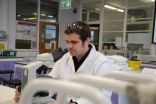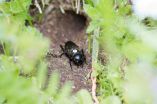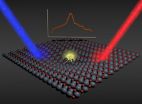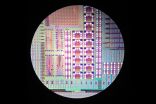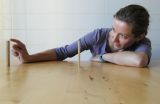(Press-News.org) CAMBRIDGE, Mass--Drizzling honey on toast can produce mesmerizing, meandering patterns, as the syrupy fluid ripples and coils in a sticky, golden thread. Dribbling paint on canvas can produce similarly serpentine loops and waves.
The patterns created by such viscous fluids can be reproduced experimentally in a setup known as a "fluid mechanical sewing machine," in which an overhead nozzle deposits a thick fluid onto a moving conveyor belt. Researchers have carried out such experiments in an effort to identify the physical factors that influence the patterns that form.
Now a group of mathematicians at MIT, Cambridge University, and elsewhere have developed a simple model to predict patterns formed by viscous fluids as they fall onto a moving surface.
The researchers looked at four patterns -- sinusoidal waves; repeating and alternating loops; and straight lines -- and observed that the pattern formed depends on the ratio between the fluid's speed on impact and the speed of the conveyor belt. The team found that this ratio influences a fluid's shape, or curvature, just before hitting the surface, which in turn determines the pattern that forms.
The team used its model to create simulations of viscous flow; these simulations matched the patterns produced in previous experiments by others.
The simple geometrical model may be easily integrated into computer graphics simulations to create realistic videos of viscous liquids like honey and oil. The model may also be used to optimize manufacturing processes for products such as nonwoven materials -- synthetic fabrics that are manufactured through an injection process that sprays polymers onto a conveyor belt, in patterns meant to resemble woven textiles.
Pierre-Thomas Brun, an instructor in MIT's Department of Mathematics, says the geometrical model provides a simple method to both predict and create patterns from viscous fluids.
"We're getting at the core of pattern formation, and explaining why transitions from pattern to pattern occur, with a very minimalistic model," Brun says. "With this method, you can have a 3-D printer inject your polymer and just move the belt at the appropriate speed, and you can get the patterns you want."
Brun and his colleagues have published their results this week in the journal Physical Review Letters.
"Boiling down" viscous flow
In 2012, researchers at the University of Toronto carried out a fluid mechanical sewing machine experiment, drizzling a viscous fluid onto a progressively slowing conveyor belt. The experiment showed that as the belt starts, moving rapidly, the fluid forms a straight line as it hits the surface. As the belt slows, the fluid, flowing at the same rate, starts to meander in a wavelike pattern, then form alternating loops, and then finally, repeating loops, as the conveyor belt grinds almost to a halt.
Brun and others have studied these experimental results, and have since come up with a detailed numerical model, called "discrete viscous robes numerics," to describe the resulting patterns, depending on factors such as fluid height, viscosity, and gravity. But Brun says this model, though precise in its predictions, contains many equations that are complex to solve.
Instead, he and his group sought to "boil down" the dynamics of viscous flow into a simpler, workable model, mainly by doing away with a complex variable: inertia, an object's resistance to any change in motion. For instance, in the case of the fluid mechanical sewing machine, the rotation of the thread generates centrifugal forces in the coil that forms on the conveyor belt.
Brun chose to model the system without inertia, in a scenario in which fluid flows from a very small height -- a scenario in which the fluid stretches under the force of gravity, but inertia does not play a role. Under these conditions, he observed that the patterns formed were the same as those created with the full, inertia-driven numerical model -- a sign that something other than inertia was determining pattern formation.
Digging into the "heel" of the problem
Brun and his colleagues found that the crux of the issue came down to what they termed the "heel" of the flow -- the point just before impact, when a fluid curves slightly, forming a heel-like shape. The researchers found that the patterns formed on the conveyor belt depend on the shape of the fluid heel. They noted the shape, or curvature, of the heel was determined by the distance and orientation between two points: the point at which the fluid first contacts the surface, and the point directly below the nozzle.
These two properties shape the curvature of the fluid as it hits the belt. The group also found that the resulting curvature determines the new angle and impact point of the fluid -- a phenomenon that induces a "memory" effect in the fluid.
"Memory is usually induced by inertia, but despite the fact that here there is no inertia, we still maintain this idea of memory, which is essential for formation of patterns," Brun says. "It's really embedded in these geometry features. Otherwise, the patterns would just be random."
Brun and his colleagues used their model to simulate the fluid mechanical sewing machine scenario, changing the shape of the heel in response to the speed of the conveyor belt. They produced four main patterns -- waves, straight lines, and alternating and repeating loops -- that matched the patterns generated by the more detailed numerical model.
The researchers say their simplified model may be geared toward optimizing a novel class of microfabrication techniques for manufacturing extremely small, tailorable textured fibers.
"We now have a very powerful tool we can use to get to the core of the experiment, to get deeper into the way these patterns are formed," Brun says.
INFORMATION:
This research was funded in part by the European Research Council.
April 23, 2015 - Interventional treatments--especially surgery--provide good functional outcomes and a high cure rate for patients with lower-grade arteriovenous malformations (AVMs) of the brain, reports the May issue of Neurosurgery, official journal of the Congress of Neurological Surgeons. The journal is published by Wolters Kluwer.
The findings contrast with a recent trial reporting better outcomes without surgery or other interventions for AVMs. "On the basis of these data, in appropriately selected patients, we recommend treatment for low-grade brain AVMs," concludes ...
A new study by the University of Chicago Booth School of Business Assistant Professor Amanda Sharkey and University of Utah Assistant Professor Patricia Bromley found that environmental ratings have spillover effects on other companies' behavior. Rated firms reduce their toxic emissions even more when their peers are also rated. In addition, rated peers can even motivate some unrated companies to reduce their emissions.
The research is unusual in that the role of peers in conditioning how firms respond to ratings systems has received little examination.
The study, "Can ...
SINCE its first use in the 1980s - a breakthrough dramatised in recent ITV series Code of a Killer - DNA profiling has been a vital tool for forensic investigators. Now researchers at the University of Huddersfield have solved one of its few limitations by successfully testing a technique for distinguishing between the DNA - or genetic fingerprint - of identical twins.
The probability of a DNA match between two unrelated individuals is about one in a billion. For two full siblings, the probability drops to one-in-10,000. But identical twins present exactly the same ...
This news release is available in German.
An individual's behaviour in risky situations is a distinct personality trait both in humans and animals that can have an immediate impact on longevity. Researchers from the Max Planck Institute for Ornithology in Seewiesen have now found differences in personality types for the first time in a population of free living field crickets. Risk-prone individuals showed a higher mortality as they stayed more often outside their burrow where they can be easily detected by predators, compared to risk averse individuals. Moreover, ...
Navigating through a cluttered environment at high speed is among the greatest challenges in biology - and it's one virtually all birds achieve with ease.
It's a feat David Williams hopes to understand.
A former post-doctoral fellow in the lab of Andrew Biewener, the Charles P. Lyman Professor of Biology, and a current post-doc at the University of Washington, Williams is the lead author of a study that shows birds use two highly stereotyped postures to avoid obstacles in flight. The study could open the door to new ways to program drones and other unmanned aerial ...
This news release is available in German.
Researchers of Karlsruhe Institute of Technology (KIT) have unveiled an important step in the conversion of light into storable energy: Together with scientists of the Fritz Haber Institute in Berlin and the Aalto University in Helsinki/Finland, they studied the formation of so-called polarons in zinc oxide. The pseudoparticles travel through the photoactive material until they are converted into electrical or chemical energy at an interface. Their findings that are of relevance to photovoltaics among others are now published ...
A Spanish-led team of European researchers at the University of Cambridge has created an electronic device so accurate that it can detect the charge of a single electron in less than one microsecond. It has been dubbed the 'gate sensor' and could be applied in quantum computers of the future to read information stored in the charge or spin of a single electron.
In the same Cambridge laboratory in the United Kingdom where the British physicist J.J. Thomson discovered the electron in 1897, European scientists have just developed a new ultra-sensitive electrical-charge sensor ...
How long is the way from the city hall to the train station? When we estimate distances, something curious happens: short distances seem longer, and long distances shorter than they really are. Similar biases occur during judgments of volume, brightness or time. Psychologists call this phenomenon Vierordt's law. Its independence of the involved sensory systems suggests that our brain possesses universal principles for the assessment of physical quantities. However, where do the characteristic estimation biases stem from? In collaboration with colleagues from Zurich, neuroscientists ...
It's a common dilemma faced by many working parents: your child has a cough or a cold, do you send them to nursery?
Researchers from the University of Bristol have, for the first time, investigated the process of decision-making that parents go through when faced with this situation. The research, published in The Journal of Public Health, reports that parents viewed coughs and colds as less serious and not as contagious as sickness and diarrhoea symptoms.
This resulted in many parents sending their child to daycare with a respiratory tract infection (RTI), which can ...
In response to an article published by Chinese scientists describing research that used gene editing technologies in human embryos, the International Society for Stem Cell Research (ISSCR) has again called for a moratorium on attempts at human clinical germline genome editing while extensive scientific analysis of the potential risks is conducted, along with broad public discussion of the societal and ethical implications. The research article, entitled "CRISPR/Cas9-mediated Gene Editing in Human Tripronuclear Zygotes," was published online on April 18 in the scientific ...
